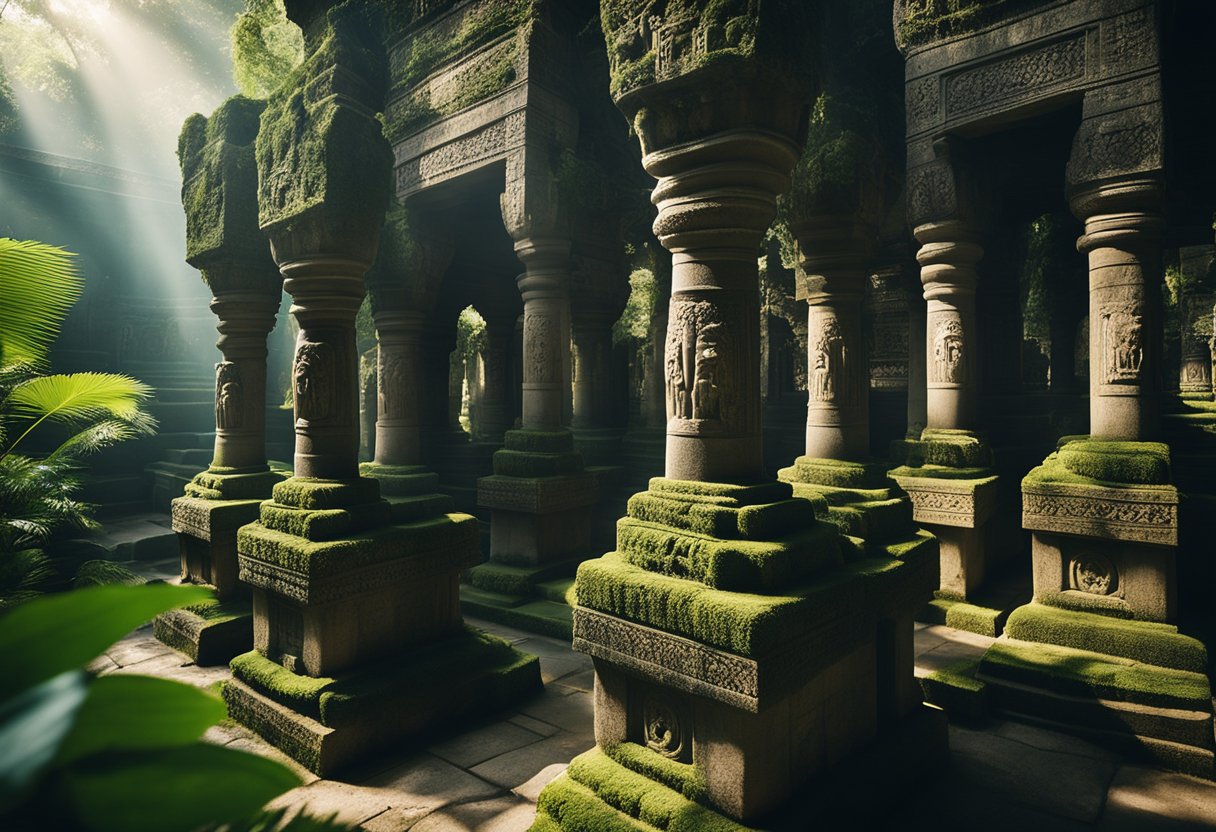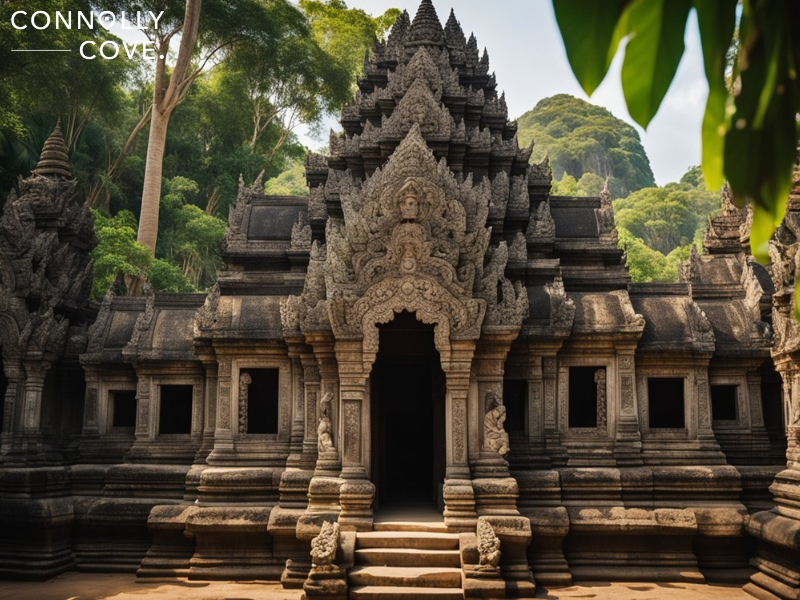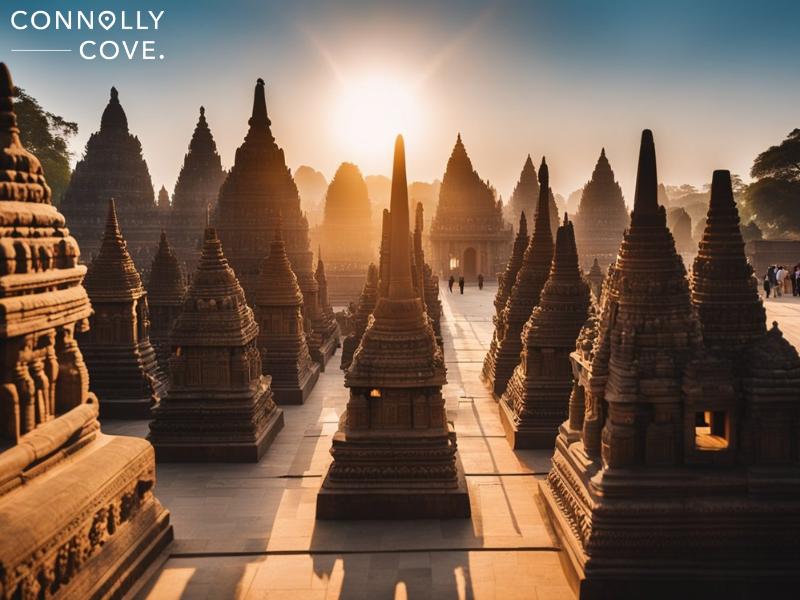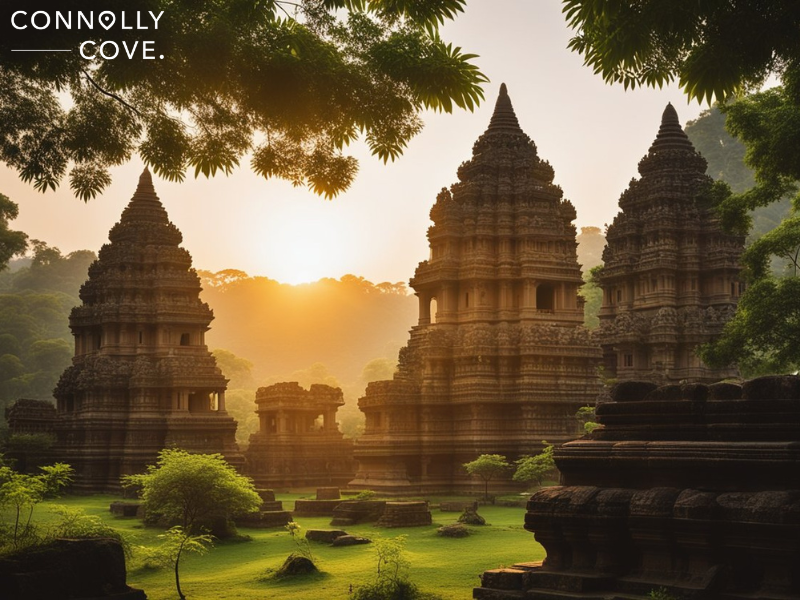Exploring the Legacy of the Khmer Civilisation!

Updated On: March 01, 2024 by Esraa Mahmoud
Nestled in the heart of Southeast Asia, Cambodia harbours the remnants of the Khmer Empire, an impressive civilisation that left behind an architectural and cultural heritage of monumental significance. These ancient temples aren’t just stone structures; they represent the zenith of Khmer creativity and the spiritual devotion of a civilisation that thrived from the 9th to the 15th centuries.
As we traverse through the dense jungles that have embraced these ruins, each temple we uncover serves as a chronicle of the past, telling tales of power, religious fervour, and incredible artistic expression. At the epicentre of this historical narrative lies Angkor Wat, a majestic testament to the Khmer Empire’s grandiosity. This temple complex, once eclipsed by the flourishing forests, now reveals an intricate fusion of symbolism and symmetry, making it a magnetic centrepiece for pilgrims and scholars alike.
Angkor Thom, the last capital city of the formidable Khmer rulers, similarly exudes historical significance through its iconic Bayon temple with countless serene faces carved into stone – an enduring legacy of King Jayavarman VII. Coming up next, we go beyond the iconic silhouettes of these time-tested edifices to delve into the societies that built them, the craftsmanship that sculpted them, and the contemporary endeavours preserving their glory for future generations.
The Cradle of Khmer Civilisation
It wouldn’t be an exaggeration if we said that the Khmer Empire is the bedrock of modern Cambodia, in a way. It’s a saga that interlaces the remarkable history of the Khmer people and their indelible mark on the land that today encompasses not just Cambodia but parts of Vietnam, Thailand, and Laos.
Cambodia’s fertile plains and strategic waterways became the nucleus of this ancient civilisation. The empire was renowned for its architectural marvels, including the majestic temple complexes that pay homage to both Hindu and Buddhist deities.
At the heart of these achievements was Angkor, the capital of the empire. Here, the prodigious temple of Angkor Wat stands as a testament to the glory of Khmer architectural artistry. Carved from the land itself, this bastion symbolises the cosmos in stone and resonates with the spiritual and cultural ethos of the civilisation.
Within Cambodia, the Khmer people fostered sturdy linkages throughout Southeast Asia, crafting an empire that merged prowess with piety. Their advancements in hydraulic engineering, evident in barays and intricate irrigation systems, sustained a complex urban infrastructure and agricultural prosperity.
The Khmer Empire’s influence, while centred in Cambodia, permeated across regional boundaries, shaping the political and cultural landscapes of neighbouring regions. The timelines etched in the stone ruins whisper of the days when Khmer rulers held sway over vast territories and left an indelible mark on history.
Gazing upon the relics of Khmer civilisation, we are reminded of the enduring legacy left by this pivotal power. One cannot help but reflect on the grandeur of their cities that once teemed with life, their temples that continued to echo the chants of ancient ceremonies, and their refined arts that are still praised to this day.
Myths and Deities: Religious Influence on Khmer Architecture

There is a complex tapestry of myths and deities surrounding the Khmer civilisation that help in understanding the splendour of Khmer architecture. This architecture reflects a civilisation where religious beliefs were intricately woven into the very stones of its temples.
Hindu Foundations and Mythology
The Hindu religion provided the original underpinnings for Khmer architectural design. Majestic temples like Angkor Wat are physical manifestations of Hindu cosmology, specifically the Hindu universe. These structures are oriented towards the west, a direction associated with the Hindu god Vishnu, whom the temple was originally dedicated to.
Bas-reliefs adorning the temple walls depict narratives from Hindu mythology, such as the Ramayana and Mahabharata, serving not only as decoration but as religious text in stone, illustrating the victories of deities like Vishnu and Shiva.
Buddhism’s Integration into Khmer Culture
As Buddhism took root in Cambodian culture, it also found expression in the country’s iconic architecture. This fusion is nowhere more evident than in the Bayon Temple, a site marked by serene, massive stone faces that exude the Buddhist philosophy of compassion.
The temple’s architectural features harmonise Buddhist symbolism with the preexisting Hindu motifs, illustrating a seamless blend of the spiritual and the material. Carvings of Buddhist scenes stand alongside Hindu epics, revealing a cultural landscape where both religions are valued and celebrated in their physical forms.
Angkor Wat: The Crown Jewel of Khmer Temples
Angkor Wat is an architectural symbol of Cambodia, mirroring the eminence of Khmer creativity and dedication of the 12th century. This temple complex is not only a testament to religious devotion but also a reflection of cosmic symbolism and royal ambition.
Architectural Marvel and Symbolism
Angkor Wat is an architectural marvel, embodying the Khmer Empire’s ingenuity. The entire complex is a scaled representation of the Hindu cosmos, with Mount Meru at its epicentre, surrounded by moats and galleries that symbolise oceans and mountain ranges. Comprising quintessential stone galleries, sandstone towers, and elaborate carvings, every facet of Angkor Wat’s intricate design is steeped in symbolism.
Dominion of King Suryavarman II
Under the dominion of King Suryavarman II, Angkor Wat reached its pinnacle. This grand edifice was both a state temple and a potential mausoleum for the king, uniting political might with religious fervour. It reflects Suryavarman’s power and his dedication to Vishnu, to whom the temple was devoted.
Mount Meru Embodied
The temple mountain style of Angkor Wat is a magnificent terrestrial mimicry of Mount Meru, the mythological abode of the gods. As the tallest temple within Angkor, it rises above the cityscapes—a stone behemoth visible from afar, commanding respect and awe. By walking through this sacred geography, we traverse a microcosm of the divine.
We acknowledge that Angkor Wat is much more than just a historic structure; it is a UNESCO World Heritage site, a cultural touchstone for humanity, and a proud emblem of Cambodia to the world.
Angkor Thom and the Bayon: A Testament to Jayavarman VII
At the heart of the once-mighty Khmer Empire lies the monumental Angkor Thom, the last great city established by King Jayavarman VII. Within this sprawling metropolis, the Bayon temple stands as a profound declaration of the King’s shift towards Mahayana Buddhism.
The Great City and Its Temples
Angkor Thom was more than merely a city; it was the zenith of Khmer architectural prowess. Founded by Jayavarman VII, the city served as the capital of the Khmer Empire towards the end of the 12th century. This great city was not only the administrative nucleus but also a focal point for the empire’s spiritual life.
Within its walls, temple complexes surged towards the sky, with the Bayon at its centre. The temples here were not just places of worship, but they also embodied the celestial order on earth. The legacy of Jayavarman VII can be keenly felt through the stones of these sanctuaries, which were integral to the daily lives of the Khmer people, serving as social centres and places of divine connection.
The Enigmatic Faces of Bayon
Amidst the myriad of temples in Angkor Thom, the Bayon commands attention with its distinctive architectural feature: the serene and smiling stone faces that adorn its towers. A truly Buddhist temple, the Bayon epitomizes the shift in religious focus instigated by Jayavarman VII, contrasting with Hindu dedications of previous rulers like Jayavarman II.
These faces, possibly depicting the bodhisattva Avalokiteshvara or even a likeness of Jayavarman VII himself, look out to the north, south, east, and west, symbolising the omnipresence of the king, both as a political leader and as a divine figure. The temple complex, thus, serves as an enduring symbol not only of the King’s religious convictions but also of his political sagacity in uniting a vast empire under his rule.
Artistic and Structural Elements of Khmer Temples
The temples of the Khmer Empire stand as a testimony to the grandeur of Cambodia’s heritage, exemplifying the pinnacle of artistic and structural achievement. Within their walls lies a fusion of symbolism and reverence, which has endured for centuries.
Symbolism Carved in Stone
At the heart of Khmer temple architecture is a profound representation of spiritual beliefs, immortalised in endless stone carvings. We observe a world where myth and history blend, with bas-reliefs at sites such as Angkor Wat portraying epic tales like the Churning of the Sea of Milk, a pivotal Hindu story. These narratives extend beyond mere decoration; they were integral to the Khmer worldview, echoing the triumphs of gods and kings alike.
Adorning Devatas and Deities
Embedded within our art and architecture, devatas and deities overlook the temple precincts with serene gazes and intricate attire. The Bayon Temple, for example, is renowned for its multitude of colossal stone faces, each one offering a silent and enigmatic watch over the old city of Angkor Thom. The walls, lined with carved lintels, further depict the celestial dancers, Apsaras, who bless these sacred spaces with their divine presence.
Material Techniques and Innovations
When we examine the ancient temples of Cambodia, it becomes evident that the Khmer people were masterful in their use of materials and construction techniques. These innovations have left a lasting imprint on the architectural world, particularly in their iconic use of sandstone and laterite.
Construction Materials
- Laterite: Used primarily for the foundation and lower levels, offering durability.
- Sandstone: Selected for higher elevation structures and carvings due to its workability.
The Khmer architecture is renowned for unique material juxtapositions. Brick was used prior to the 10th century but was largely superseded by more durable materials.
Architectural Techniques
- Ashlar masonry: We can see this in the precise joining of stone blocks without mortar.
- Raised platforms and enclosures: These were often built with laterite, supporting the structures’ mass.
- Restorative interventions: Wood was employed to prevent extensive damage, respecting the original materials.
An examination of the architectural remnants would show that sandstone was the preferred material for elaborate carvings due to its versatility and availability. Moreover, the use of stone rather than wood in the construction of iconic temples like Angkor Wat facilitated their preservation, allowing us to marvel at these structures even today.
In essence, the Khmer Empire showcased advanced understanding in the selection and manipulation of materials—expertly adapting to local resources to create enduring monuments that continue to captivate us with their grandeur and intricacy.
Historical Records and Observations
As we explore the ancient temples of Cambodia, we’re guided by historical records and observations that have been made over the centuries. Through the detailed accounts of Chinese travellers and the efforts of European explorers, a vivid picture of the past emerges, allowing us to piece together the grandeur of the Khmer Empire.
Chinese Travellers’ Insights
Zhou Daguan, a Chinese emissary, provided one of the most valuable historical records of the Khmer Empire during his visit to Angkor in the late 13th century. Zhou’s documentation offers detailed observations of daily life, religious ceremonies, and the magnificent architecture in Siem Reap, including the awe-inspiring Angkor Wat. His writings give us rare and important insights into the empire at its zenith.
European Explorers and Conservation
In the 19th century, European explorers like Henri Mouhot rekindled global interest in the Cambodian temples. Mouhot’s discovery and writings significantly contributed to bringing the ruins to the attention of the West.
Following these findings, France, under its protectorate in Cambodia, initiated efforts to preserve and restore these historical sites. The legacy of these explorers and the subsequent conservation work are crucial in understanding and maintaining the grand temples built by the Khmer civilization.
Beyond the Temples: Society and Economy of the Khmer

The ancient Khmer Empire was not only remarkable for its temples but also for its advanced society and economy. We delve into aspects such as trade and the daily lives of people during the empire’s zenith.
Trade and Cultural Exchanges
Trade was a cornerstone of the Khmer Empire’s economy, whereby the Mekong River served as a vital artery for transport. Siem Reap and other cities flourished as hubs where goods from China, India, and beyond were exchanged, fostering rich cultural diversity.
Such interactions resulted in a society steeped in multicultural influences, where artistic and religious ideas coalesced, enhancing the harmony among different cultures. Trade with neighbours brought prosperity and innovation, fuelling the empire’s growth.
Everyday Life of Khmer Society
The everyday life of ordinary people in the Khmer Empire revolved around rice cultivation and fishing—activities central to their sustenance and culture. Within their communities, there was a strong emphasis on family and social harmony. Festivals and religious ceremonies underscored their spiritual and cultural life, reflecting a deep connection to both the land and the divine. Moreover, knowledge and customs were passed down through generations, ensuring the continuity of their rich culture.
Regional Conflicts and Cultural Interactions
We must explore how the Ancient Temples of Cambodia are not just stone structures but symbols of past regional conflicts and cultural interactions, illustrating extensive historical connections across Indochina and beyond.
Encounters with Neighbouring Lands
The Khmer Empire, seated in the heart of what is today Cambodia, was historically engaged in a series of battles and alliances with its surrounding nations. This led to a complex web of regional interactions, particularly with Siam (modern-day Thailand), Vietnam, and Laos. Military campaigns often became pathways for cultural exchange, as each civilisation left its imprint on the others.
Siam served as both an adversary and an ally throughout history, with the famous Angkor Wat temple bearing witness to the Siamese attempt to claim authority over the region. Meanwhile, trade and conflict with Vietnam and Laos introduced various aspects of Khmer influence into their cultures, evident in architectural designs and linguistic exchanges.
Influences from Javanese and Champa Kingdoms
Just as the Khmer Empire projected its power outward, it, too, was subject to external influences, particularly from the Javanese and Champa kingdoms. The empire engaged in both trade and political relations with these maritime powers, which is evident in the intricate bas-reliefs that grace the walls of Cambodia’s ancient edifices.
The Javanese influence can be seen in the Hindu-Buddhist religious synthesis that is a hallmark of Khmer architecture. Furthermore, the Champa Kingdoms, especially Vijaya, facilitated a blend of cultures, resulting in shared religious practices and the introduction of Cham elements into Khmer tradition. These interactions were important in shaping the societal dynamics within the vast Indochinese region.
Preservation Efforts and Modern-Day Relevance

Any examination of the ancient temples of Cambodia reveals an enduring significance intricately tied to both heritage conservation and contemporary allure. Among these, Angkor Wat stands as a beacon of the Khmer Empire’s prowess, with an architecture that beckons countless visitors and the protective gaze of conservationists.
UNESCO marked Angkor as a World Heritage site in 1992, reflecting a commitment to safeguarding this magnificent relic of the past. The preservation of Angkor is a collaborative endeavour, combining both local and international resources to address issues such as structural damage and the impact of encroaching vegetation. This monumental task leverages scientific restoration techniques to ensure the site endures for generations to come.
Our cultural heritage is enriched by such sites, and it is our collective responsibility to conserve their grandeur. Tourism plays a pivotal role in both the appreciation and preservation of these temples. Visitors to Siem Reap, the gateway to Angkor, partake in an immersive cultural experience that transcends mere sightseeing.
| Entity | Role in Preservation and Relevance |
|---|---|
| UNESCO | Provides oversight and guidance for preservation efforts |
| World Heritage Site | Recognition as a site of global significance |
| Conservation | Application of methods to maintain and restore the structures |
| Cultural Heritage | Emphasis on the importance of the site to humanity’s history |
| Tourism | Encourages respectful exploration, aiding economic support |
| Siem Reap | Acts as the hub for visitors, fostering understanding and revenue |
These endeavours are not just about maintaining bricks and mortars; they symbolise our pledge to the valourisation of cultural heritage as a whole. As custodians of history, we strive to balance the sustenance of the structures with the essence of the Khmer legacy, ensuring its relevance echoes into modernity.






